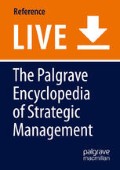Abstract
Firms consist of people who make decisions to achieve goals. How do these people develop the expectations which underpin the choices they make? The lens model provides one answer to this question. It was developed by cognitive psychologist (Brunswik, Egon. The conceptual framework of psychology. Chicago: University of Chicago Press, 1952) to illustrate his theory of probabilistic functionalism, and concerns the environment and the mind, and adaptation by the latter to the former. This entry is about the lens model, and probabilistic functionalism more broadly. Focus will mostly be on firms and their employees, but, to fully appreciate the scope, we have to keep in mind the fact that probabilistic functionalism extends to all purposive organisms. Probabilistic functionalism is currently experiencing growing interest among strategy scholars, and some very recent papers are highlighted in conclusion.
This entry was originally published on Palgrave Connect under ISBN 978-1-137-49190-9. The content has not been changed.
References
Bowman, E.H. 1982. A risk/return paradox for strategic management. Sloan Management Review 23: 17–31.
Brunswik, E. 1943. Organismic achievement and environmental probability. Psychological Review 50: 255–272.
Brunswik, E. 1952. The conceptual framework of psychology. Chicago: University of Chicago Press.
Brunswik, E. 1957. Scope and aspects of the cognitive problem. In Contemporary approaches to cognition, ed. H. Gruber, R. Jessor, and K. Hammond. Cambridge, MA: Harvard University Press.
Csaszar, F.A. 2013. How organizational structure can compensate for flawed mental representations. Working paper, University of Michigan.
Hogarth, R.M., and N. Karelaia. 2011. Entrepreneurial success and failure: Confidence and fallible judgment. Organization Science 23: 1–15.
Krechevsky, D. 1932. Hypotheses versus chance in the pre-solution period in sensory discrimination learning. University of California Publications in Psychology 6: 27–44.
Kristensen, K., H. Jørn Juhl, J. Eskildsen, J. Nielsen, N. Frederiksen, and C. Bisgaard. 2006. Determinants of absenteeism in a large Danish bank. International Journal of Human Resource Management 17: 1645–1658. Available at http://www.tandfonline.com/doi/abs/10.1080/09585190600878527. Accessed 25 Apr 2013.
March, J.G., and H.A. Simon. 1958. Organizations. New York: Wiley.
Nash, U.W. 2012. A theory of correlated expectations. Ph.D. Dissertation, University of Southern Denmark.
Ng, T.W.H., and D.C. Feldman. 2009. How broadly does education contribute to job performance? Personnel Psychology 62: 89–134. Available at http://doi.wiley.com/10.1111/j.1744-6570.2008 Accessed 25 Apr 2013.
Popper, K. 1999. All life is problem solving. New York: Routledge.
Shannon, C., and W. Weaver. 1948. A mathematical theory of communication. System 27: 379–423. Available at http://circuit.ucsd.edu/~yhk/ece287a-win08/shannon1948.pdf. Accessed 25 Apr 2013.
Simon, H.A. 1947. Administrative behavior: A study of decision-making processes in administrative organization. New York: Free Press.
Tolman, E.C., and E. Brunswik. 1935. The organism and the causal texture of the environment. Psychological Review 42: 43–77.
Tucker, L.R. 1964. A suggested alternative formulation in the developments by Hursch, Hammond, and Hursch, and Hammon, Hursch, and Todd. Psychological Review 71: 528–530.
Weiss, A. 1995. Human capital vs. signalling explanations of wages. Journal of Economic Perspectives 9: 133–154. Available at http://www.jstor.org/stable/10.2307/2138394. Accessed 25 Apr 2013.
Author information
Authors and Affiliations
Corresponding author
Editor information
Editors and Affiliations
Copyright information
© 2016 The Author(s)
About this entry
Cite this entry
Nash, U.W. (2016). Lens Model. In: Augier, M., Teece, D. (eds) The Palgrave Encyclopedia of Strategic Management. Palgrave Macmillan, London. https://doi.org/10.1057/978-1-349-94848-2_319-1
Download citation
DOI: https://doi.org/10.1057/978-1-349-94848-2_319-1
Received:
Accepted:
Published:
Publisher Name: Palgrave Macmillan, London
Online ISBN: 978-1-349-94848-2
eBook Packages: Springer Reference Business and ManagementReference Module Humanities and Social SciencesReference Module Business, Economics and Social Sciences

